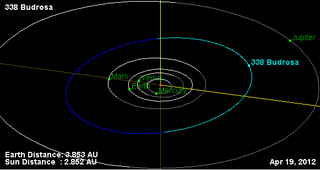
Bettina is a large main belt asteroid that was discovered by Austrian astronomer Johann Palisa on September 3, 1885, in Vienna. It was named in honour of Baroness Bettina von Rothschild, wife of Baron Albert von Rothschild who had bought the naming rights for £50. Based upon the spectrum, it is classified as an M-type asteroid.

Tamara is a large Main belt asteroid. It is classified as a C-type asteroid and is probably composed of carbonaceous material. It is the largest member and namesake of the Tamara Family, a 264 million year-old sub-family of the collisional Phocaea family.

Gudrun is a main-belt asteroid.

Siri is a main belt asteroid in orbit around the Sun. It was discovered by German astronomer Max Wolf on 19 March 1892 in Heidelberg. The origin of this asteroid's name is unclear. On October 5, 2092, 332 Siri will pass 4,981,670 km (3,095,470 mi) from the asteroid 29 Amphitrite with a relative velocity of 2.054 kilometers per second.

Chicago is a very large main-belt asteroid. It is classified as a C-type asteroid and is probably composed of carbonaceous material.

Lacadiera is a large Main belt asteroid. It is classified as a D-type asteroid and is probably composed of organic rich silicates, carbon and anhydrous silicates. The asteroid was discovered by Auguste Charlois on 19 September 1892 in Nice.

Devosa is a large Main belt asteroid. It was discovered by Auguste Charlois on 22 September 1892 in Nice. The asteroid is orbiting the Sun at a distance of 2.38 AU with a period of 3.68 years and an eccentricity (ovalness) of 0.14. These orbital elements are similar to that of the large asteroid 4 Vesta. The orbital plane of 337 Devosa is tilted at an angle of 7.85° to the plane of the ecliptic.

Budrosa is a large Main belt asteroid. It is classified as an M-type asteroid. It was discovered by Auguste Charlois on 25 September 1892 in Nice.

Dorothea is a large main belt asteroid that was discovered by German astronomer Max Wolf on 25 September 1892 in Heidelberg.

Eduarda is a main belt asteroid that was discovered by German astronomer Max Wolf on 25 September 1892 in Heidelberg. It was named after German banker and amateur astronomer Heinrich Eduard von Lade.

California is an asteroid belonging to the Flora family in the Main Belt. It was discovered by Max Wolf on 25 September 1892 in Heidelberg, and is named for the U.S. state of California. This object is orbiting the Sun at a distance of 2.20 AU with a period of 3.26 yr and an eccentricity (ovalness) of 0.19. The orbital plane is inclined at an angle of 5.7° to the plane of the ecliptic.

Endymion is a large Main belt asteroid. It was discovered by Max Wolf on 17 October 1892 in Heidelberg. It was the first asteroid to receive the name of a male god.

343 Ostara is a background asteroid from the inner region of the asteroid belt. It was discovered by German astronomer Max Wolf at the Heidelberg Observatory on 15 November 1892.

Desiderata is a very large main-belt asteroid. It is classified as a C-type asteroid and is probably composed of carbonaceous material.

Tercidina is a large main-belt asteroid. It is classified as a C-type asteroid and is probably composed of carbonaceous material.

347 Pariana is a metallic background asteroid from the central region of the asteroid belt. It was discovered by French astronomer Auguste Charlois at the Nice Observatory on 28 November 1892. The M-type asteroid has a short rotation period of 4.1 hours and measures approximately 49 kilometers in diameter. The origin of the asteroid's name remains unknown.

May is a large Main belt asteroid. It was discovered by Auguste Charlois on 28 November 1892 in Nice, and was named for the German author Karl May. This asteroid is orbiting the Sun at a distance of 2.97 AU with a period of 5.12 years and an eccentricity (ovalness) of 0.067. The orbital plane is inclined at an angle of 9.7° to the plane of the ecliptic. During its orbit, this asteroid has made close approaches to the dwarf planet Ceres. For example, in September 1984 the two were separated by 6.3 Gm (0.042 AU).

(87269) 2000 OO67 (prov. designation:2000 OO67) is a trans-Neptunian object, approximately 64 kilometers (40 miles) in diameter, on a highly eccentric orbit in the outermost region of the Solar System. It was discovered by astronomers at the Chilean Cerro Tololo Inter-American Observatory on 29 July 2000.

621 Werdandi is a Themistian asteroid.

852 Wladilena is a Phocaea asteroid from the inner region of the asteroid belt. It is named after the Russian Communist leader Vladimir Lenin.




















